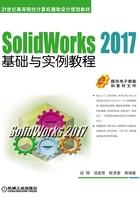
3.2 实体拉伸特征
实体拉伸特征是将一个截面沿着与截面垂直的方向延伸,进而形成实体的方法。拉伸特征适合创建比较规则的实体。拉伸特征是最基本和常用的特征创建方法,而且操作比较简单,工业生产中的多数零件模型,都可以看作是多个拉伸特征相互叠加或切除的结果。
在SolidWorks中,创建实体拉伸特征的命令包括“拉伸凸台/基体”和“拉伸切除”。
3.2.1 拉伸凸台/基体
单击“特征”面板上的“拉伸凸台/基体”按钮 ,或选择“插入”→“凸台/基体”→“拉伸”命令,即可执行“拉伸凸台/基体”命令。
,或选择“插入”→“凸台/基体”→“拉伸”命令,即可执行“拉伸凸台/基体”命令。
执行“拉伸凸台/基体”命令后,可以打开如图3-4所示的“拉伸”属性对话框,选择一个基本平面,绘制草图,退出草图后会弹出如图3-5所示的“凸台-拉伸”属性对话框。

图3-4 “拉伸”对话框
在“凸台-拉伸”属性对话框中,系统提供了多种方式来定义实体的拉伸长度,如图3-6所示。

图3-5 “凸台-拉伸”属性对话框

图3-6 拉伸方式
1. 给定深度
(1)单向拉伸
如图3-7所示,在“方向1”中选择拉伸方式的拉伸长度,然后输入拉伸距离,也可以拖动鼠标指定距离,则创建单向拉伸。单向拉伸是最常用的拉伸方式。

图3-7 单向设定拉伸距离
(2)双向拉伸
在“凸台-拉伸”属性对话框中选中“方向2”复选框并指定距离,可以进行双向拉伸,如图3-8所示。

图3-8 双向设定拉伸距离
(3)拔模拉伸
在“凸台-拉伸”属性对话框中单击“拔模”按钮 ,并输入角度,可以在拉伸的同时给定拔模斜度,如图3-9所示。
,并输入角度,可以在拉伸的同时给定拔模斜度,如图3-9所示。

图3-9 增加拔模斜度拉伸
(4)薄壁拉伸
在“凸台-拉伸”属性对话框中选中“薄壁特征”复选框,输入厚度值,可以拉伸生成薄壁实体,如图3-10所示。

图3-10 增加薄壁特征拉伸
2. 完全贯穿
拉伸特征沿拉伸方向穿越已有的所有特征。如图3-11所示是完全贯穿的拉伸特征。

图3-11 完全贯穿
3. 成形到下一面
拉伸特征沿拉伸方向延伸至下一表面,与“成形到一面”的区别是不用选择面。
4. 成形到一顶点
拉伸特征延伸至一个顶点位置,如图3-12所示。
5. 成形到一面
拉伸特征沿拉伸方向延伸至指定的零件表面或一个基准面,如图3-13所示。

图3-12 成形到一顶点

图3-13 成形到一面
6. 到离指定面指定的距离
拉伸特征延伸至距一个指定平面一定距离的位置,如图3-14所示。指定距离以指定平面为基准。
7. 成形到实体
该方式和“成形到一面”类似,区别是选择的目标对象为实体而不是面。
8. 两侧对称
拉伸特征以草绘平面为中心向两侧对称拉伸,如图3-15所示。拉伸长度两侧均分,输入的深度是拉伸的总深度。

图3-14 到离指定面指定的距离

图3-15 两侧对称
3.2.2 实例:电插头
绘制如图3-16所示的电插头。
1. 创建实体1
① 单击“新建”按钮 ,选择零件模块。
,选择零件模块。
② 选择“上视基准面”作为绘图平面,绘制如图3-17所示的草图。单击绘图区域右上角的“退出草图”按钮 ,退出草图。
,退出草图。
③ 选中已绘制的草图,单击“特征”面板中的“拉伸凸台/基体”按钮 ,打开如图3-18所示的“凸台-拉伸”属性对话框,选择“给定深度”选项,输入3,单击“确定”按钮
,打开如图3-18所示的“凸台-拉伸”属性对话框,选择“给定深度”选项,输入3,单击“确定”按钮 ,生成如图3-19所示的实体。
,生成如图3-19所示的实体。
2. 创建实体2
① 选择如图3-20所示的绘图平面,单击“草图”按钮,绘制如图3-21所示的草图。单击绘图区域右上角的“退出草图”按钮 ,退出草图。
,退出草图。

图3-16 电插头
1—实体12—实体23—实体34—实体4

图3-17 绘制草图

图3-18 “凸台-拉伸”属性对话框

图3-19 拉伸实体
② 单击“特征”面板中的“拉伸凸台/基体”按钮 ,打开如图3-22所示的“拉伸”属性对话框,选择特征树中的“草图2”,弹出如图3-23所示的“凸台-拉伸”属性对话框,选择“给定深度”选项,输入10,单击“确定”按钮
,打开如图3-22所示的“拉伸”属性对话框,选择特征树中的“草图2”,弹出如图3-23所示的“凸台-拉伸”属性对话框,选择“给定深度”选项,输入10,单击“确定”按钮 ,生成如图3-24所示的实体。
,生成如图3-24所示的实体。

图3-20 选择实体表面为绘图平面

图3-21 绘制草图

图3-22 “拉伸”属性对话框

图3-23 “凸台-拉伸”属性对话框

图3-24 拉伸第二段实体
3. 创建实体3
① 选择实体上如图3-25箭头所指的面作为绘制草图平面,进入草图环境后,单击“草图”面板上的“转换实体引用”按钮 ,左侧弹出“转换实体引用”属性对话框,如图3-26所示。选中“选择链”复选框,然后选择如图3-25箭头所指的平面,即可将该平面的4条边线转换为草图线,单击绘图区域右上角的“退出草图”按钮
,左侧弹出“转换实体引用”属性对话框,如图3-26所示。选中“选择链”复选框,然后选择如图3-25箭头所指的平面,即可将该平面的4条边线转换为草图线,单击绘图区域右上角的“退出草图”按钮 ,退出草图。
,退出草图。

图3-25 绘制草图

图3-26 “转换实体引用”属性对话框
② 单击“特征”面板中的“拉伸凸台/基体”按钮 ,在“凸台-拉伸”属性对话框中选择“给定深度”选项,输入10;选择“拔模”选项,输入25,如图3-27所示,单击“确定”按钮
,在“凸台-拉伸”属性对话框中选择“给定深度”选项,输入10;选择“拔模”选项,输入25,如图3-27所示,单击“确定”按钮 ,生成如图3-28所示的实体。
,生成如图3-28所示的实体。

图3-27 添加拔模斜度

图3-28 拉伸第三段
4. 创建实体4
① 选择实体上如图3-29箭头所指的面作为绘制草图平面,进入草图环境后,利用尺寸约束和几何约束命令,绘制如图3-30所示的草图,单击绘图区域右上角的“退出草图”按钮 ,退出草图。
,退出草图。

图3-29 选择草图面

图3-30 拉伸最后段
② 单击“特征”面板中的“拉伸凸台/基体”按钮 ,在“凸台-拉伸”属性对话框中选择“给定深度”选项,输入16,单击“确定”按钮
,在“凸台-拉伸”属性对话框中选择“给定深度”选项,输入16,单击“确定”按钮 ,即可生成如图3-16所示的电插头实体特征。
,即可生成如图3-16所示的电插头实体特征。
3.2.3 拉伸切除
单击“特征”面板上的“切除-拉伸”按钮 ,或选择“插入”→“切除”→“拉伸”命令,即可执行“切除-拉伸”操作。
,或选择“插入”→“切除”→“拉伸”命令,即可执行“切除-拉伸”操作。
“切除-拉伸”属性对话框如图3-31所示,该对话框中的选项和“拉伸凸台/基体”命令类似,同样可以一侧或两侧拉伸,如图3-32所示,可以生成拔模斜度、薄壁等结构,这里不再赘述。

图3-31 “切除-拉伸”属性对话框

图3-32 切除-拉伸类型
如图3-33所示列除了几种按不同给定长度方式生成的拉伸切除特征。

图3-33 “切除-拉伸”特征
a)两侧对称 b)成形到一面 c)离指定面指定距离 d)完全贯穿
3.2.4 实例:轴承座
绘制如图3-34所示的轴承座,尺寸参考步骤中的数值。
1. 创建底座
① 单击“新建”按钮 ,选择零件模块。
,选择零件模块。
② 选择“上视基准面”作为绘图平面,绘制如图3-35所示的草图。单击绘图区域右上角的“退出草图”按钮 ,退出草图。
,退出草图。

图3-34 轴承座

图3-35 绘制底座草图
③ 单击“特征”面板中的“拉伸凸台/基体”按钮 ,打开如图3-36所示的“凸台-拉伸”属性对话框,将“深度”设定为20,单击“确定”按钮
,打开如图3-36所示的“凸台-拉伸”属性对话框,将“深度”设定为20,单击“确定”按钮 ,生成如图3-37所示的实体。
,生成如图3-37所示的实体。

图3-36 “凸台-拉伸”属性对话框

图3-37 拉伸底座
2. 创建开槽和孔
① 选择如图3-38所示的绘图平面,单击“草图”按钮,绘制如图3-39所示草图。单击绘图区域右上角的“退出草图”按钮 ,退出草图。
,退出草图。

图3-38 选择实体表面为绘图平面

图3-39 绘制开槽草图
② 选中该草图,单击“特征”面板中的“切除-拉伸”按钮 ,弹出如图3-40所示的“切除-拉伸”属性对话框,在“方向1”下拉列表中选择“贯穿全部”选项,单击“确定”按钮
,弹出如图3-40所示的“切除-拉伸”属性对话框,在“方向1”下拉列表中选择“贯穿全部”选项,单击“确定”按钮 ,生成如图3-41所示的开槽。
,生成如图3-41所示的开槽。

图3-40 “切除-拉伸”属性对话框

图3-41 拉伸开槽
③ 选择实体上表面作为绘制草图平面,绘制如图3-42所示的草图,捕捉4个小圆和圆角同心以定位。单击绘图区域右上角的“退出草图”按钮 ,退出草图。
,退出草图。
④ 单击“特征”面板中的“切除-拉伸”按钮 ,在“切除-拉伸”属性对话框的“方向1”下拉列表中选择“贯穿全部”选项,单击“确定”按钮
,在“切除-拉伸”属性对话框的“方向1”下拉列表中选择“贯穿全部”选项,单击“确定”按钮 ,生成如图3-43所示的实体。
,生成如图3-43所示的实体。

图3-42 绘制孔草图

图3-43 拉伸穿孔
3. 创建背板
① 选择实体背面作为绘制草图平面,如图3-44所示,绘制如图3-45所示的草图。单击绘图区域右上角的“退出草图”按钮 ,退出草图。
,退出草图。

图3-44 选择草图面

图3-45 绘制背板草图
② 单击“特征”面板中的“拉伸凸台/基体”按钮 ,在“凸台-拉伸”属性对话框的“方向1”下拉列表中选择“给定深度”选项,将“深度”设置为20,单击“确定”按钮
,在“凸台-拉伸”属性对话框的“方向1”下拉列表中选择“给定深度”选项,将“深度”设置为20,单击“确定”按钮 ,生成如图3-46所示的实体。
,生成如图3-46所示的实体。
4. 创建加强筋
① 选择“右视基准面”作为绘制草图平面,绘制如图3-47所示的草图,注意三角形要封闭。单击绘图区域右上角的“退出草图”按钮 ,退出草图。
,退出草图。

图3-46 创建背板

图3-47 绘制加强筋草图
② 单击“特征”面板中的“拉伸凸台/基体”按钮 ,在“凸台-拉伸”属性对话框的“方向1”下拉列表中选择“两侧对称”选项,将“深度”设定为20,单击“确定”按钮
,在“凸台-拉伸”属性对话框的“方向1”下拉列表中选择“两侧对称”选项,将“深度”设定为20,单击“确定”按钮 ,即可完成如图3-34所示的轴承座实体。
,即可完成如图3-34所示的轴承座实体。